#GeoFence
Explore tagged Tumblr posts
Text
Fleettrack Lite Wired GPS Tracker for Car, Bike, Scooty, Truck, Bus | Location Tracker | Engine ON/Off Alerts | Geofence Alert & More 15+ Features
Price: (as of – Details) Product Description 📦 PACKAGE INCLUDES – GPS TRACKING UNIT WITH SIM: GPS Tracking Unit with Inactive SIM ❌, Compatible with all vehicle types. SIM activation required for use. Just pay Rs. 999 via Fleettrack app to activate 1 Year sim data.📞 24/7 CUSTOMER SUPPORT – WHATSAPP HELPLINE: Quick Customer Support for technical queries. Raise a request on our 24/7 WhatsApp…

View On WordPress
#Alert#Alerts#Bike#Bus#Car#Engine#Features#Fleettrack#Geofence#GPS#Lite#Location#next gen store#ONOff#Scooty#Tracker#Truck#Wired
0 notes
Text
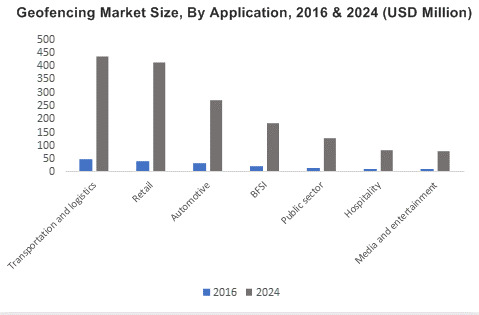
Discover the magic behind geofencing technology! From enhancing customer engagement to improving operational efficiency, find out why businesses are leveraging this game-changing tool to stay ahead of the curve.
0 notes
Text
GeoFence Technology & Its Advantages
GeoFence tech is the absolute best in revolutionary security technology for your home. We would like to talk about GeoFence tech in detail so you can understand why it’s become so popular and why it will come as a benefit to your home's security.
If you are ready to enhance your residential security, we can help! Go to our website to see our products and services! Give us a call if you have any questions.

🔒 Read More: https://www.smartvisionplus.ca/blog/geofence-technology-its-advantages/ 📞 Phone: 1-833-880-4591 📬 Email: [email protected] 📍 Location: Thornhill and Greater Toronto Area
#GeoFenceTechnology#GeoFenceTech#SecurityTechnology#GeoFence#SecurityCamera#SecuritySystem#TorontoSecurityCameras#TorontoHomes#AffordableSecurityCameras#Security#Safety#TorontoSecurity#TorontoSecuritySystems#GTASecurityCamera#GTASecuritySystems#GTAAlarmSystems#GTAHomeAutomation#AffordableSecuritySystems#AffordableSecuritySystemInstallation#HomeSecurity#HomeSecurityTips#HomeSecurityCameras#Toronto#TorontoHomeSecurity#SecurityInstallationCompany#TorontoSecurityInstallationCompany#SecurityInstallationCompanyToronto
0 notes
Text
I think the grossest thing in America is diametrically opposed religious organizations mashing their dogma together over nationalism, property and power. And it all ties together with fast food. And they are always the first to cry cultural appropriation when an individual step outside their personal geographic boundaries in a way that doesn’t please the neighborhood . Maybe judge the dumb look on your face when you trip over the clearly marked red lines in the constitution. Would you like fries with that? Maybe a slice of cheesecake? How about some humble pie? You look like a dumbass. 🍟
0 notes
Text
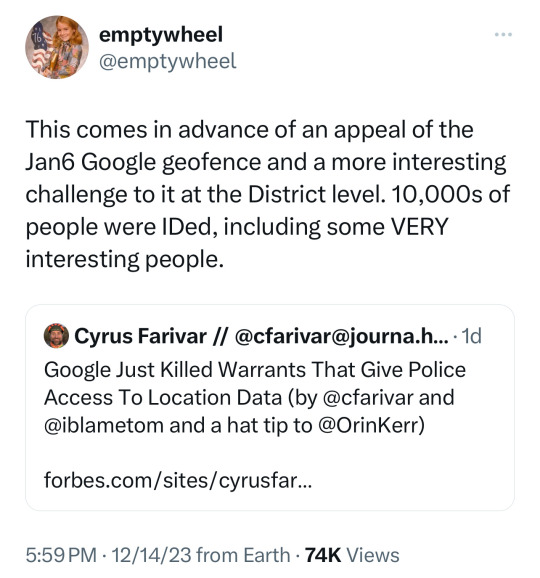

So here is the long and short of it:
Google used (uses) geofencing data, location data that undeniably shows where you and your phone have been.
Google sells this data to data brokers and advertisers, whether you like it or not. And yeah, it wouldn’t surprise me if Apple also did/does this, but if they do, Tim Cook has done a yeoman’s job of keeping it secret.
Google also hands out your location data to police departments (and governmental agencies led by conservative, anti-abortion Republicans, but I’m sure that’s unimportant, right?).
Now—and here’s the crux of the matter—just as the government was using Google’s location data to prosecute January 6th rioters, Google has had a sudden change of heart and will effectively limit their ability to remotely store your GPS information on their servers (which means it will mostly only be available locally on your Android phone’s hard drive, thus making it significantly harder - not completely impossible - for Google to give the police access to bulk location data, even if presented with a search warrant).
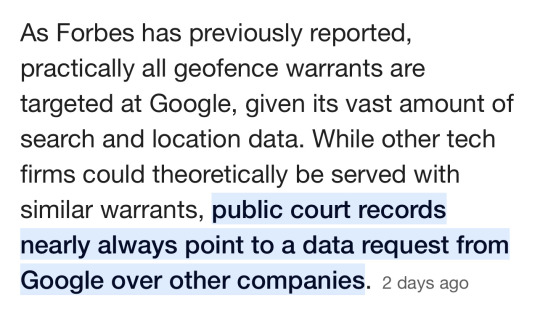
The bottom line is, it was always wrong for Google to collect and then sell their “reverse location search data” to advertisers, data miners, the police and the government. The germane question is, why now? Why has Google suddenly found Jesus, so to speak, and decided that customers privacy rights are sacrosanct, just as the U.S. government is using that data to prosecute Trump sycophants who wanted to overthrow the election?
SN: I think the whole green bubble vs. blue bubble argument is a stupid made up problem by whiny people who don’t have enough real problems in life (if you disagree then please go make your own post), and Idgaf if you’re an Android or an iPhone user. If you’re happy with your phone, that’s all that matters — but our privacy rights constantly being violated isn’t trivial, that’s actually very important. And Google suddenly deciding that now is the best time for them to end their practice of ratting people out seems highly sus.
👉🏿 https://www.emptywheel.net/2023/11/25/the-maga-tourist-geofence-and-the-violent-confederate-flag-toting-geofence/
👉🏿 https://www.forbes.com/sites/cyrusfarivar/2023/12/14/google-just-killed-geofence-warrants-police-location-data/
#politics#google#location data#privacy rights#surveillance state#geofencing#reverse location searches#andriod#android phones#j6#j6 insurrection
129 notes
·
View notes
Text
Hero of the Week: February 12, 2024: Dr. Joseph Mercola

“By debanking me, my CEO, CFO, their spouses and children, Chase Bank is giving people a foretaste of how central bank digital currencies (CBDCs) will be used to control the masses.” ~ Dr. Joseph Mercola
“… Because of his vast following and positions on health matters, Mercola has been faced with intense scrutiny and censorship, as well as, more recently, restrictions on his and his associates’ bank accounts. He is now pushing back on the threat of financial transaction control. We applaud him for continuing to highlight a wide range of important concerns…”
Full Report: https://home.solari.com/hero-of-the-week-february-12-2024-dr-joseph-mercola/
Subscribe to Solari | Follow @solarireport
17 notes
·
View notes
Text

8 notes
·
View notes
Text
How to add Geofencing using WordPress taxi booking plugin?
Stop losing your riders, add Geofencing using the WordPress Taxi Booking plugin -Ecab Follow the video now! #woocomerceplugin
#wordpressplugin
#geofencing
#intercity
#taxibooking
#ecab
youtube
#wordpressplugin#woocomerceplugin#wordpress plugins#taxiservice#taxi booking#geofencing#intercity#Youtube
2 notes
·
View notes
Text
“If you don’t collect [the data] you can’t give it to the government or have it breached by hackers,” EFF’s Andrew Crocker told The Guardian.
#geofencing #surveillance #privacy
#geofencing#surveillance#anti surveillance#privacy#invasion of privacy#october#1312#acab1312#acab#all cops are bastards#all cops are bad#political#police state#police#politics#class war#cops#kkkops#kkkop#anti cop#anti police#ausgov#politas#auspol#tasgov#taspol#australia#fuck neoliberals#neoliberal capitalism#anthony albanese
3 notes
·
View notes
Text
Is Geofencing Competitors’ Locations Effective?

Modern businesses harness the power of geofencing to advertise their local brands to people with strong buying intent. The specialty of this marketing approach is you can target prospects within a predefined geographic location near your business area. For example, if you own a café in a commercial zone. You can target nearby office buildings, shopping complexes, bus/train stations, etc. to find desired customers.
Besides, some enterprises even choose competitors’ locations for geofencing advertising. They believe it's the most convenient technique to lure away competitors' customers and grow sales. However, some people are yet to discover the effectiveness of geofencing competitors' locations. Are you one among them? If so, reading this blog, you will have a great takeaway.
A Brief Introduction to Competitor Geofencing
Suppose you are driving to a nearby restaurant for lunch. Suddenly a message from another restaurant pops up on your mobile device saying, "Get 20% off on today's menu. Avail the offer now.” Won't you love dining at this restaurant? Such ads presenting attractive offers often excite potential customers to visit the business. This marketing method to attract competitors’ customers with promotional ads is competitor geofencing or geo-conquesting. The process involves creating geofences around competitor stores, collecting and assessing customer data, and creating and distributing personalized ads.
However, you should know your target audiences and identify competitor locations to set up a successful competitor geofencing ad campaign.
Want to launch a competitor geofencing ad campaign? You can look for a trusted geofencing marketing partner to know the appropriate practices for this.
Benefits of Geofencing Competitors’ Locations
Now that you have a basic idea about geofencing competitors’ locations, it’s time to know its compelling benefits.
Competitor geofencing helps a business create a competitive edge in the market. It is possible in multiple ways.
· Since you are targeting a competitor store, you can obviously get in touch with people interested in your products or services. It helps businesses reach more relevant audiences and build a loyal customer base.
· Instead of luring away prospects stepping into a competitor store, you can also attract people who have recently visited the location. For example, if you own a retail store, you can target audiences who have entered your competitor's outlet in the past week. In this way, you can engage more customers and increase in-store traffic.
· Besides, when you geofence competitor locations, you can target prospects near that selected location. Indirectly, you can attract these audiences with timely offers and encourage them to visit your store at least once.
Are you excited to know more? You can visit this link for better knowledge.
Takeaway
Geofencing competitors’ locations is a marketing technique to strengthen customer engagement and boost marketing revenues. Big brands like Burger King use this geofencing idea to grow their sales target. What about you?
If you want to set up this location-targeting ad campaign around your competitors, you can find companies like Get Geofencing to assist you. You can talk to the experts to strategize your ad campaign according to your business requirements.
7 notes
·
View notes
Text
Between Two Buns
Sometimes I go to the vault to find a topic for The Daily Blog. After all, there is a wealth of teachable moments in the past. If there is one thing we marketers will be remembered for is that we are a bottomless pit of newsworthy actions, from amazing successes to dismal failures.
And as it turned out, Oldest Daughter shared a TikTok Reel with me a few days ago recounting one of those successes. I quickly knew I had to use this tale once more, which I had covered in The Daily Blog on 5th December 2018. From the 4th through the 12th that month, Burger King trolled McDonald’s by launching a promotion that required people to go to McDonald’s first.
Huh?
It was all about what was then a fairly new idea, geofencing. Basically, it involves setting up a virtual perimeter, and typically, businesses set one up around their own property. But Burger King did the opposite, setting up the perimeter around 14,000 McDonald’s locations. Once within the perimeter, which was usually set at about a 600-foot radius, an offer of a 1-cent Whopper would pop up in the Burger King app. The goal was to divert customers, and the effort has become legendary.

Of course, there is always risk in sending potential customers to a competitor first, and Burger King had to think strategically as to which McDonald’s locations to fence, because if there wasn’t a BK unit nearby, people would probably give up and just get a Big Mac. And if you didn’t own a smartphone AND had not downloaded the app, this promo just went flying right by your head.
Still, this was guerrilla marketing executed pretty much without flaw. Well, except that once Burger King did it, I have not heard of it being done again, at least not on a large scale. It’s one of those things that everyone quickly figured out could be used endlessly against anyone. Including you. Remember that Golden Rule? Yeah. While BK was no doubt giddy about this, imagine if McDonald’s had responded in kind? Or, worse yet, all the other burger joints formed a coalition to show Burger King a thing or two?
At some point, you just become a bad neighbor, and while it is always possible to play this card, maybe you shouldn’t. Tit for tat, you know. It might not end well.
That said, I am still a big fan of geofencing when it comes to your own property. Burger King could have done the whole promo using its own locations exclusively, but no. They wanted workers and managers in those McDonald’s locations to see people pulling in, and then leaving without ordering. That’s both diabolically delicious, as well as cruising for a bruising.
Looking back nearly five years now, we see that while the promo was a hit, it didn’t really change anything. Burger King has only a 1.2-percent share of the market. You really don’t want to poke a sleeping bear, and in this case, the bear—McDonald’s—could have crushed BK if it wanted to. Burger King should count its blessings.
And we should count this as yet another example of a high-tech strategy that worked, but one that should be realigned to focus more on the marketer and not so much on the competitor. Just because you can, does not always mean you should. It was cute. Some might say brilliant. I agree, but it was risky.
I’d put that fence over on my property, and work on being a better neighbor. Robert Frost once wrote, “Good fences make good neighbors.” I’m with him.
Dr “Having It My Way” Gerlich
Audio Blog
2 notes
·
View notes
Text
What is Geofencing: Understanding Location-Based Technology
Discover the concept of geofencing and delve into the realm of location-based technology. This comprehensive guide offers insights into how geofencing works, its applications across various industries, and its potential benefits for businesses and consumers alike. Gain a clear understanding of how geofencing enables businesses to create virtual boundaries, trigger notifications or actions based on users' proximity to specific locations, and enhance personalized experiences. Explore the innovative possibilities of geofencing technology and its role in shaping the future of location-based services.
Visit - https://www.workstatus.io/blog/workforce-management/what-is-geofencing/
#what is geofencing#geo fencing meaning#geofencing software#what does geofencing mean#geo fencing system#what is geofencing used for#how does geofencing work#geofencing technology#geofence#what is geofence#what is a geofence#geofence location#geo fencing technology#geofence tracker#geofencing meaning#geo fenced#how accurate is geofencing#gps geofencing
1 note
·
View note
Photo
Casually mentioned to a coworker that my phone is permanently on a VPN and the location is turned off unless I need to navigate, and they didn't understand why I even bothered.
"Government/advertisers already know everything about everyone, what's the point?"
That's the point
I value my privacy. I will take appropriate measures to protect it. I know it's not foolproof. That doesn't mean we shouldn't try.

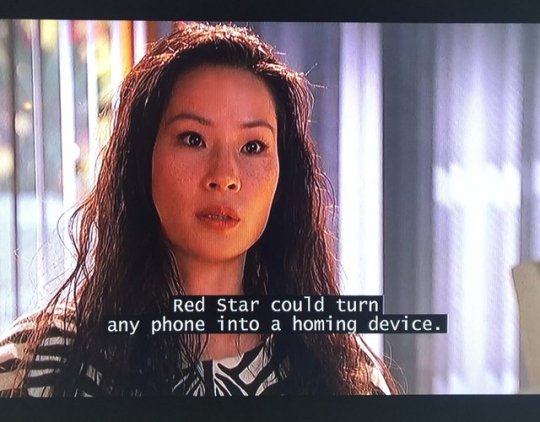

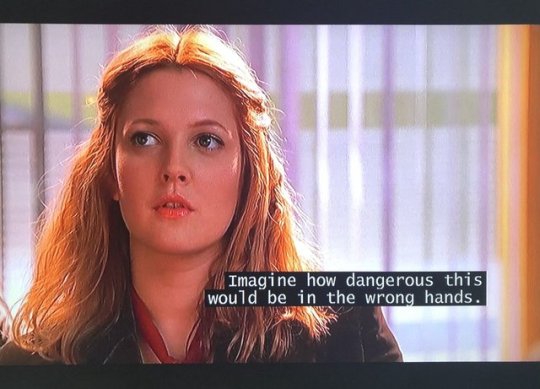
142K notes
·
View notes
Text
OTT Advertising Trends Every Small Business Should Watch in 2025

The Rise of OTT Advertising in Small Business Marketing
OTT advertising has evolved rapidly, becoming an essential tool for small businesses. Staying updated on trends ensures your campaigns remain competitive.
Trend 1: Increased Personalization
OTT platforms now offer AI-driven personalization. Ads can be tailored to individual preferences, increasing engagement and ROI.
Trend 2: Growth of Shoppable Ads
Interactive, shoppable ads allow viewers to purchase directly from the ad. Learn more about shoppable video ads and how they’re transforming the industry.
Trend 3: Expanded Reach Across Devices
OTT viewership is diversifying across TVs, smartphones, tablets, and gaming consoles. Businesses must optimize ads for multiple screen sizes.
Trend 4: Integration with Other Marketing Channels
OTT campaigns now integrate seamlessly with email, social media, and search engine marketing. Use tools like Brandify’s Marketing Dashboard to manage omnichannel campaigns.
Trend 5: Advanced Analytics and Attribution Models
OTT platforms are enhancing analytics to provide actionable insights. Metrics like engagement rates, customer lifetime value, and multi-touch attribution are now readily available.
How Small Businesses Can Leverage These Trends
Adopt AI and Machine Learning: Use AI-powered platforms for precise targeting and real-time campaign optimization.
Create Interactive Content: Experiment with quizzes, polls, and shoppable features.
Expand Beyond TV Screens: Target viewers on mobile and desktop devices.
Common FAQs About OTT Advertising Trends
Q: How do interactive ads benefit small businesses? Interactive ads drive higher engagement, allowing viewers to take immediate action, such as making a purchase or signing up for a service.
Q: Are advanced analytics expensive to implement? Not necessarily. Platforms like Google’s Analytics Suite and Brandify provide affordable solutions.
Why These Trends Matter
Staying ahead of OTT trends ensures your business maximizes its advertising potential while staying relevant to changing viewer habits.
Future-Proof Your Strategy
Explore Brandify’s OTT Advertising Solutions to stay ahead of the competition and implement these trends in your next campaign.
Press Release: https://www.prlog.org/13053451
0 notes
Text
10 Steps to Launching a Successful OTT Advertising Campaign for Small Businesses

Why OTT Advertising Is a Game-Changer for Small Businesses
OTT advertising allows small businesses to bypass traditional barriers like high costs and limited targeting options. With platforms like Hulu, Roku, and Amazon Fire TV, you can target specific demographics, behaviors, and locations.
Step 1: Define Your Goals
Start by identifying what you want to achieve: brand awareness, lead generation, or direct sales. Clear goals will guide your strategy.
Step 2: Choose the Right OTT Platform
Each platform serves unique demographics. For example:
Hulu: Ideal for reaching millennial and Gen Z viewers.
Roku: Great for local campaigns.
Amazon Fire TV: Best for integrating with existing Amazon advertising strategies.
Explore this guide to OTT platforms to choose the best fit for your business.
Step 3: Identify Your Audience
Leverage data from your website and social media to understand your audience's preferences. Tools like Brandify’s OTT Campaign Builder can help you create precise audience profiles.
Step 4: Set a Realistic Budget
OTT advertising is flexible, with options ranging from $500 to tens of thousands of dollars. Allocate your budget based on expected ROI and campaign goals.
Step 5: Craft Compelling Ad Creatives
Keep ads short, visually appealing, and focused on solving a problem or fulfilling a need.
Step 6: Use Advanced Targeting Options
OTT platforms offer:
Geotargeting to focus on specific regions.
Behavioral targeting for personalized ads.
Device targeting to optimize cross-device engagement.
Step 7: Integrate Retargeting Campaigns
Retarget viewers who’ve interacted with your brand on other platforms. Learn how retargeting boosts ROI from this guide by WordStream.
Step 8: Monitor Campaign Performance
Track metrics like CPM (Cost per Thousand Impressions), CTR (Click-Through Rate), and conversions.
Step 9: Optimize Your Campaign
Regularly test different creatives, audience segments, and ad formats to improve performance.
Step 10: Collaborate with Experts
Consider working with platforms like Brandify’s OTT Advertising Services to streamline campaign setup and tracking.
OTT Advertising Made Simple
Launching a successful OTT campaign requires planning, creativity, and a data-driven approach. By following these steps, you can unlock the potential of OTT advertising for your small business.
Press Release: https://www.prlog.org/13053451
0 notes
Text
Why Contactless Attendance is the New Standard: Exploring the Importance of Hygiene, Security, and Efficiency in Modern Workplaces

Contactless attendance is the future of the workplace! With Praesentia’s advanced face recognition and liveness detection technology, businesses can ensure a hygienic, secure, and efficient environment.
By eliminating physical touchpoints, Praesentia strengthens security with real-time identity verification, while safeguarding sensitive data through robust encryption.
Upgrade your workplace to the new standard—where health, security, and efficiency come together seamlessly.
To learn more, read our latest blog: https://www.linkedin.com/pulse/why-contactless-attendance-new-standard-exploring-odgic
Connect with us for more information!
#Call: +91-9266213979 Email: [email protected] Visit: https://systellartechnologies.com/praesentia
#time and attendance system#contactless attendance system#biometrics#face recognition#liveness detection#geofencing technology#geolocation technology#workforce management system
0 notes